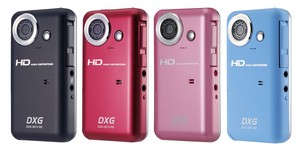DXG Launches the DXG-567V HD Camcorder With Easy Upload to YouTube and Other Web Video Sites
 Priced at Only $179, the DXG-567V HD Is the "Everyman" HD Camcorder With All the Bells and Whistles at an Affordable Price
Priced at Only $179, the DXG-567V HD Is the "Everyman" HD Camcorder With All the Bells and Whistles at an Affordable PriceCITY OF INDUSTRY, CA--(Marketwire - June 26, 2008) - DXG USA (www.dxgusa.com), one of the fastest growing digital camera manufacturers in the U.S., today unveiled the new DXG-567V high-definition (HD) camcorder with direct uploading capabilities for sites such as YouTube™. The DXG-567V is not much bigger than an average mobile phone, is available now at retailers nationwide in 4 eye-popping colors including black, red, pink and sky blue, and is priced at just $179 (MSRP.)
The DXG-567V HD camcorder is perfect for anyone looking for a fun, pocket-sized, easy and reasonably priced way to capture high-quality video and quickly upload and post it online. The DXG-567V also ships with all of the required cables including S-video for connecting the camcorder directly to a TV as well as composite video and rechargeable AA batteries, making it the ultimate multi-function video camera for the entire family.
"Rapid Blog Manager" Software Offers Fast Video Upload
The DXG-567V camcorder comes with Rapid Blog Manager software, which allows users to upload and share videos on the Internet. Simply connect the DXG-567V's retractable USB connector to a computer to automatically launch its menu and instantly upload videos from the camera to YouTube, a blog or other Web video site.
Experience HD at an Affordable Price
With the DXG-567V, it's never been easier to capture and share high-definition video, up to 1280 x 720 at 30 frames-per-second (FPS). The camcorder's buttons are all within reach, eliminating complex menus and making it easier to record spontaneous moments in high-definition video. When back at home, consumers can easily connect the DXG-567V to any plasma or HDTV with the included cables to experience the videos they've shot in HD.
Out of the box, the DXG-567V includes the ArcSoft TotalMedia™ Extreme software (a $99 retail value,) to create, edit and watch videos. The software features two unique applications that enhance the movie-watching experience with features and options right and a separate program that allows consumers to make amazing customized movies.
About DXG USA
DXG USA, The Digital Camera Company, is one of the fastest growing digital camera manufacturers in the U.S., providing intuitively designed digital cameras and camcorders for the youth and mainstream markets. Compact, fashionable and affordably priced, DXG digital cameras are setting trends for quality and utility. DXG USA is a fully owned subsidiary of DXG Technology Corp., one of the world's leading manufacturers and designers (OEM/ODM) of digital cameras and camcorders. DXG Technology has won numerous design and innovation awards and employs more than 4,000 people worldwide. Complete information on DXG USA can be found at www.dxgusa.com.
The names of companies mentioned herein are the trademarks of their respective owners.
Read More......





















